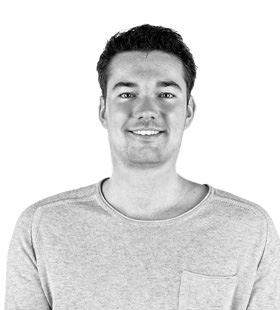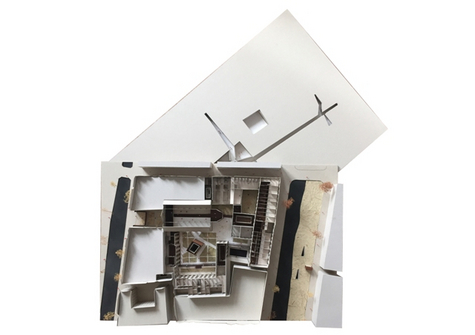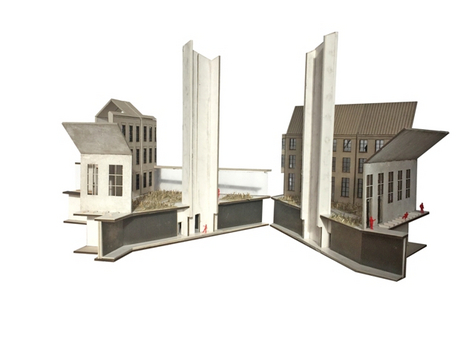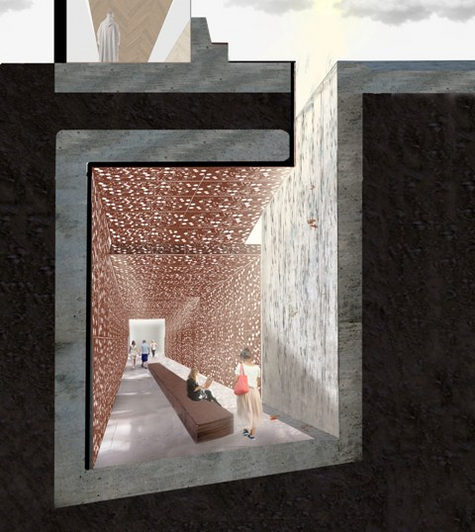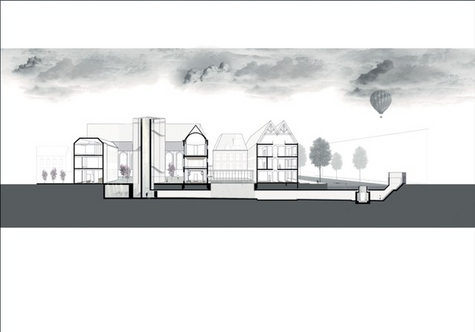Nicky Kroes
Time Out...
Claustrum Silentium, or enclosed silence.
I have a kitchen garden. Largely because of the vegetables that come from there, but also because the simple work in the garden brings calm to my busy existence. In order to reach this garden, I have to cycle about five minutes. The route goes through a residential estate and continues via a dyke along the water and the meadows bordering the Bijlmermeer. I gradually discovered during my graduation that the short cycle route to my garden is part of the moment of silence that I experience when I am occupied there. The moment that I get on my bicycle, I am busy with the garden and I forget all kinds of unimportant matters. In my graduation project ‘Claustrum Silentium’, the route to the moment of silence became an important theme during the design process.
For years and years, you live in top gear, you no longer have time for relaxation. We are much too busy with everything and anything. There is a constant need for silence. Unfortunately, there is not much peace and quiet in our society. It never stops. We live in a time of globalisation and a 24-hour economy. Due to urbanisation, the city will gain an increasing amount of ground, as a result of which ‘silent spots’ will slowly disappear. You are searching for a spot where you can find this peace and quiet. Certain types of buildings traditionally provide this silence. You grow quiet here, because that’s the way it’s supposed to be. Find a sense of calm here, because the building gives you that feeling automatically. These are buildings like a church, a museum, a library and a convent or monastery.
Many people associate a visit to a convent or monastery with religion. Not strange given that this was its original function. But an increasingly fewer people are searching for religion. In spite of this fact, convents and monasteries are gaining in popularity. People are visiting the convent or monastery in the form of a retreat. They are looking for peace, but avoid the religious aspect. This fact is somewhat contradictory to what monastic/convent life stands for.
The redefinition is responsible for a new types of building and includes all the qualities of a convent or monastery, such as scale, pace of life, materialisation and positioning of functions, as a result of which the feeling of the old convent or monastery is preserved, but also provides space for new programme elements which modern man craves.
In my eyes, the assignment was very simple: to provide the answer to the question that so many people are yearning to find. Creating a spot in the city where you can escape from the hustle and bustle of daily life. The new ‘convent/monastery’ that I envision is a publicly accessible, non-religious building. It can be found in Amsterdam at a spot where the contrast between commotion and silence is the greatest. It provides a place of peace and quiet for anyone who is searching for that. A visit to this spot can last a morning, but it may also entail you stay here for a longer time and may even come to live here. It has to be a place where you can freely walk in and out in part and which can form a genuine oasis of calm in the city.
As I have already indicated, the rout is an important part of the moment of silence. My design has three different entrances, each with its own quality. In order to get people out of their daily rhythm and to have the moment of silence begin already when entering the building, they will be led through the entrance slowly. This will take place by means of underground routes, after which the visitor will rise again to the heart of the building. The route will end in the contemplation tower, from where the visitor will disperse further through the building. During these routes, the senses of the visitors will be engaged and it will be possible to stay here for a short time.
The second design theme is layering. Claustrum Silentium has three types of visitors. The day visitor, a week visitor (retreat) and the permanent resident who runs the building. Just as with old convents/monasteries, there is a clear hierarchy in the spaces, which indicates where which visitor is allowed to enter. The day visitor will have access to the garden with orchard, part of the silent chapel, and can participate in yoga or sculpture lessons in one of the classrooms.
The week visitor will have access to the following layer. They will go on a retreat and will therefore participate in the pace of life of Claustrum Silentium. They will have their own part of the building with dormitories, can participate in all lessons and will also join the permanent residents at a certain moment. Finally, there is the layer with the permanent residents. They will be located at the edge of the city and will be best able to close themselves off from outside noise. Transitions to the following later will always occur in the same way, so that it is clear that you are leaving a particular layer. In addition, the layering will also be expressed by means of materialisation. In this way, it will always be clear where you are in the building.
Graduation committee: Marlies Boterman (mentor), Tom Bergevoet, Martin Hopman.

